Lungs found in mysterious deep-sea fish
Loading...
A deep-water fish found mostly off the coast of southern Africa has been found to have non-functional lungs, according to a study published Tuesday in Nature Communications.
Latimeria chalumnae is no ordinary fish. Besides possessing vestigial lungs, the species is frequently called a “living fossil” for being part of the order coelacanth, which was long thought extinct.
L. chalumnae was discovered in a fisherman’s net in 1938, and it bore remarkable similarities to fossils of coelacanths, fish thought to have died with the dinosaurs 65 million years ago.
The presence of lungs, albeit seemingly useless ones, in the L. chalumnae may answer some questions about its relationship to its ancient cousins. Researchers say some coelacanths survived the Cretaceous/Palaeogene extinction event that killed off the land-dwelling dinosaurs because they had already adapted to deep water. This adaptation would have made lungs unnecessary organs for the fish.
The coelacanths that are only known in the fossil record appear to have calcified lungs. Perhaps, scientists say, those lungs were to help the fish live in shallower waters where lungs would have been more advantageous.
In the early embryo, the L. chalumnae lung develops just as a useful lung would. But as the fish grows to adulthood, the lung grows slower and slower, ultimately becoming just a vestigial organ.
The researchers in this study also examined a fatty organ that seems to help the modern coelacanth stay buoyant deep in the ocean. It is unknown whether ancient coelacanths possessed this peculiar organ, as soft-tissue would not be preserved in fossils.
The animal’s lung’s development slows as it grows, but this fatty organ continues to grow. While the lung is a vestigial organ, the fatty organ still seems to provide an important function to the L. chalumnae.
Other living fish have been found to have lungs and be capable of breathing air. The bichir, or dragon fish, dwells in shallower water and relies on lungs to breathe, unlike the gilled L. chalumnae.
A bichir can also use its short fins to pull itself on land, much like it is trying to walk. Researchers found in 2014 that if they raised the bichirs on land, the fish better developed their land-dwelling traits, those similar to other animals with four limbs.
Coelacanths also use their fins much like they are walking through the water rather than swimming. In fact, researchers found that the coelacanth carries some DNA that can stimulate limb growth. A 2013 study revealed that when some of that DNA was put into mice, they grew additional limbs.






